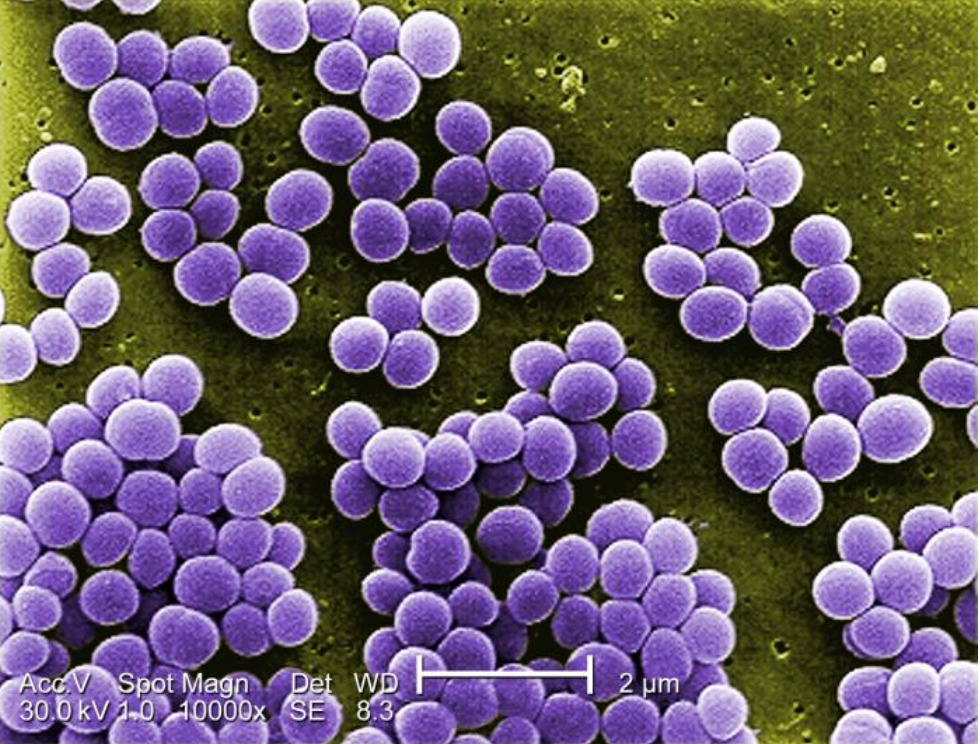Playlist
Show Playlist
Hide Playlist
Staphylococci
-
Slides 02 BacterialDiseases MicrobiologyAdvanced.pdf
-
Download Lecture Overview
00:01 Hello and welcome to Bacterial Infections. Today we're going to talk about Staphylococcus and Streptococcus, and when you listen to this lecture, you'll be able to know the structure and virulence factors produced by the staphylococci and the streptococci. You will be familiar with the pathogenesis and the epidemiology of diseases associated with staphylococci and streptococci. You'll know which drugs can be used to treat staphylococcal and streptococcal infections, and you will become acquainted with the available streptococcal vaccines. 00:42 Let's dive into staphylococci first. These are causative agents of abscesses and toxin-mediated diseases. Here we have a photograph of staphylococcus aureus. These are gram-positive cocci and they're often called grape-like clusters, so if they look like grapes to you, purplish, so that's the morphological appearance of staphylococci. Staphylococci colonized the nose and other mucous membranes in the skin of 30 to 40% of humans. 30 to 40% of people are carrying these bacteria as part of their normal flora, not everyone, alright, but some of them do, in your nose, mucous membranes, even on your skin. These bacteria nevertheless, under some situations, can cause a variety of diseases. They include focal abscesses and what we mean by that is an abscess in a very specific place, like on the skin, where it would be a boil, many of you may have had boils before, focal infections, a very raised pus filled lesion, we will see some of these in a moment, but these can also occur inside of you, not just on your skin, for example in your lungs, bones, other organs, kidneys and heart. A general feature of the staphylococci is that they secrete potent exotoxins. We talked about exotoxins in a previous lecture on bacteria, these are proteins that are produced and elaborated from the bacteria that have effects on the host. In the case of staphylococci, these include the toxic shock syndrome toxin, staphylococcal scalded skin syndrome and food poisoning. These are all a consequence of the production of toxins. The toxic shock, the scalded skin, the food poisoning are all consequences of toxin production and their effects. 02:55 So among the toxins that staphylococci produce are lipases and hydrolases. These have as an effect to degrade the lipids of your skin and that in part contributes to the production of these boils. These staphylococci can spread from person-to-person via aerosols, respiratory spread produced by coughing or sneezing or even talking. Did you know that as I'm speaking now I'm actually making an aerosol and so if you're standing right in front of me, you could be infected and in particular, letters like P, P, where I'm sending out puffs of aerosol, that's one way that people can spread, I don't have to sneeze or cough. So person-to-person by respiratory aerosols or by direct contact, these bacteria can be transmitted. Of course if you already have the staphylococci, this is not relevant, but as I said there are many people who don't have them and they can acquire them from others by these routes of transmission.
About the Lecture
The lecture Staphylococci by Vincent Racaniello, PhD is from the course Bacteria.
Included Quiz Questions
Which of the following describes the morphology of Staphylococcus aureus?
- Gram-positive cocci in clusters
- Gram-negative cocci in clusters
- Gram-positive cocci in chains
- Gram-negative cocci in chains
- Gram-negative cocci in pairs
Staphylococci are considered normal flora when located in which of the following body structures?
- Nares
- Lungs
- Bone
- Heart
- Eyes
Which of the following is a toxin secreted by staphylococci?
- Hydrolase
- Transcriptase
- Nitrogenase
- Acetyltransferase
Customer reviews
3,3 of 5 stars
| 5 Stars |
|
1 |
| 4 Stars |
|
0 |
| 3 Stars |
|
1 |
| 2 Stars |
|
1 |
| 1 Star |
|
0 |
Perfect... I undarstant many things here... Nice explanation Wish best for you
not enough details, like the fast staph. is Catalase-positive and non motile . more details needed.
This set of lectures on Staph were very generalized and did not cover the other Staph bacteria commonly seen on STEP 1 (i.e. saprophyticus and epidermidis). This seems to be a common theme of not going deep enough to cover material necessary for STEP, yet advertising that you all cover enough material for STEP 1.




